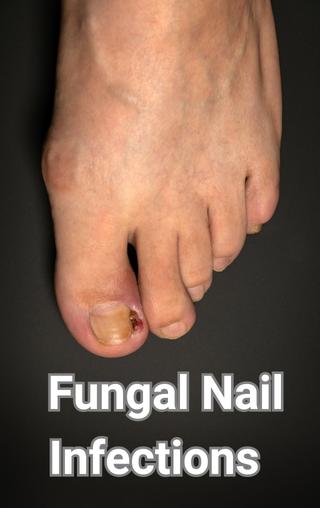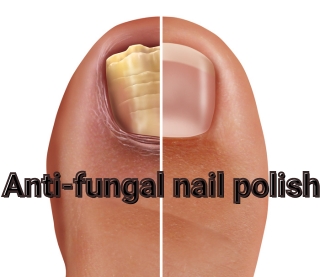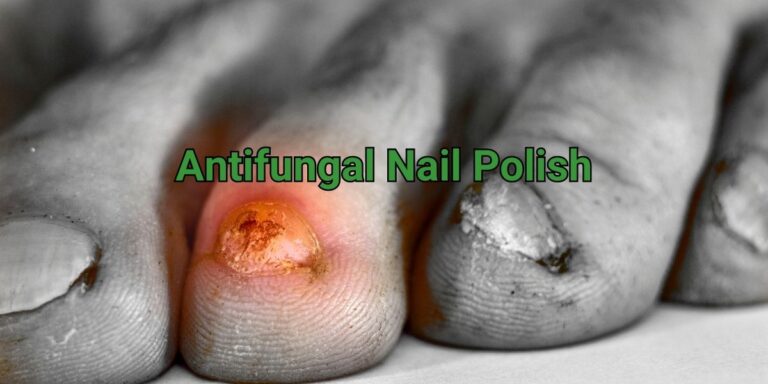Introduction to Antifungal Nail Polish
-
Antifungal nail polish and its purpose in treating fungal nail infections
Antifungal nail polish is considered the first treatment that comes to people’s minds when they experience fungal nail infection and are afraid of having side effects related to the oral treatment. Antifungal nail polish differs from regular nail polish as it contains growth-inhibiting and antifungal ingredients that can fight onychomycosis (Fungal nail infection) successfully. Antifungal Nail polishes can be purchased without a prescription from the pharmacy.
Understanding Fungal Nail Infections
-
Symptoms and Causes of fungal nail infections
When you experience Brittle nails with whitish-yellowish or brownish color, you may have the symptoms of nail fungus. The nails may change in shape and become thicker. Sometimes, The affected nail may detach from the nail bed.
Fungal nail infections can occur due to different fungi types that live in the environment. Small cracks in the nails or the surrounding area may allow the fungus to enter the nail and cause infection.

-
Importance of early detection and treatment for successful recovery
Fungal nail infection is difficult to be treated, therefore the treatment must be started early to get the best results.
Benefits of Antifungal Nail Polish
-
Advantages of using antifungal nail polish for fungal nail infections
- Minimal side effects.
- Easy and convenient to use.
- Can be applied under cosmetic nail polish.
- Can be purchased from the pharmacy without a prescription.
Proper Application and Usage
-
Step-by-step instructions on how to apply antifungal nail polish correctly
- Cut and file down the affected nail as much as possible before applying the nail polish.
- The old layer of polish has to be removed using an alcohol swab before applying the new layer.
- Cosmetic nail polish may be applied on top of the medicated nail polish.
-
Recommended frequency and duration of use for optimal results
Different types of antifungal nail polish differ in how often they are used:
- Amorolfine antifungal nail polish is applied 1 – 2 times per week.
- Ciclopirox antifungal nail polish is applied every other day in the first month, then 2 times per week in the second month, and once a week in the third month.
Ciclopirox or Amorolfine suppress fungal growth by disrupting their cell membrane or inhibiting cell growth. However, the infection is very persistent and the treatment may take up to one year.
Additional Measures for Preventing Fungal Nail Infections
-
Tips on foot hygiene, footwear considerations, and avoiding reinfection
- Your hands and feet must be kept clean and dry.
- Fingernails and toenails should be kept short and clean.
- Don’t walk barefoot in public areas.
- Don’t share nail clippers with others.
- Choose a clean and licensed nail salon that sterilizes the instruments after each use.

Safety Precautions and Considerations
-
potential side effects of antifungal nail polish
- Mild burning
- Itching
- Redness
-
Considerations for individuals with allergies or sensitivities
Stop using the nail polish and seek medical help if you have signs of an allergic reaction (difficulty breathing, swelling of face, lips, tongue, or throat, severe itching)
Effectiveness and Expected Results
Antifungal nail polish may be a suitable treatment option for mild to moderate cases but it may not be effective in severe cases that usually require oral antifungal medications.
Conclusion
Anti-fungal nail polish is an excellent solution for mild to moderate fungal nail infection and may be used as an adjuvant treatment in severe cases, It can be purchased and applied easily.
Nevertheless, If you are using nail polish or the oral form you must be patient as fungal nail infections need time to be treated.
Why does Weltopiarx recommend Antifungal Nail polish?
Welltopia offers a Fungal Nail solution that is rich in diverse active ingredients that are capable of fighting and terminating fungal infections.
Ingredients:
- Ciclopirox olamine 8%: Broad spectrum antimycotic that is effective against dermatophytes, yeasts, and molds. Ciclopirox combined with a penetration enhancer can be an effective formula in the treatment of toenail fungus.
- Itraconazole 3%: Potent antifungal because it can cause impairment in the fungal membrane structure and function.
- Terbinafine 1%: act as fungistatic (stop fungal growth) and fungicidal (kill the already formed fungus)
- Ibuprofen 2%: act as an Analgesic & Anti-inflammatory. Ibuprofen compounded with other ingredients into a topical solution has benefits when compared to taking the same drug by mouth: to break biofilm-related infections.
- Hydroxypropyl cellulose 1%: additive
- Dimethyl sulfoxide (DMSO): solvent
Directions of use: Used on the affected area once daily.
You can ask your doctor to fill in this form If you want to order the compounded Fungal Nail solution. If you don’t have a prescriber please include your information here and we will contact you and connect you with an experienced practitioner.

References
Nail fungus: Polish, cream, or tablets? – NCBI







